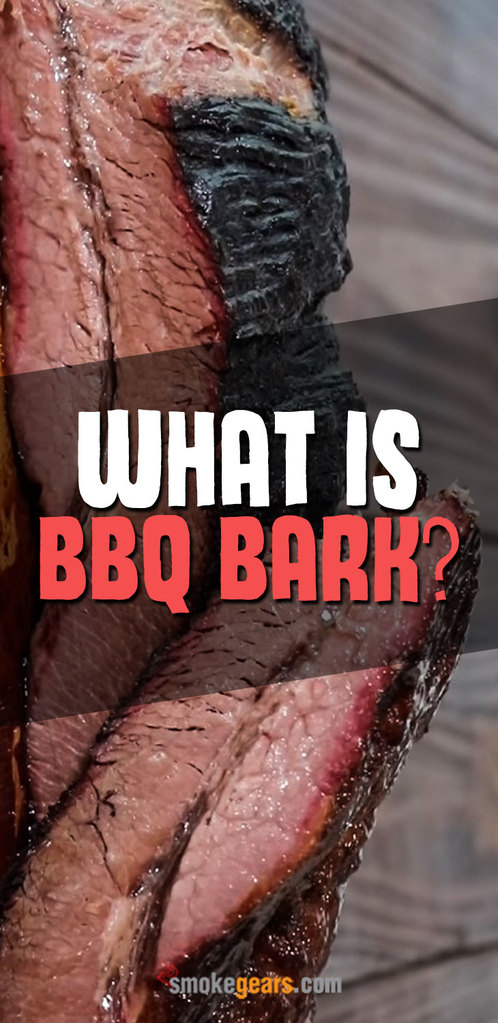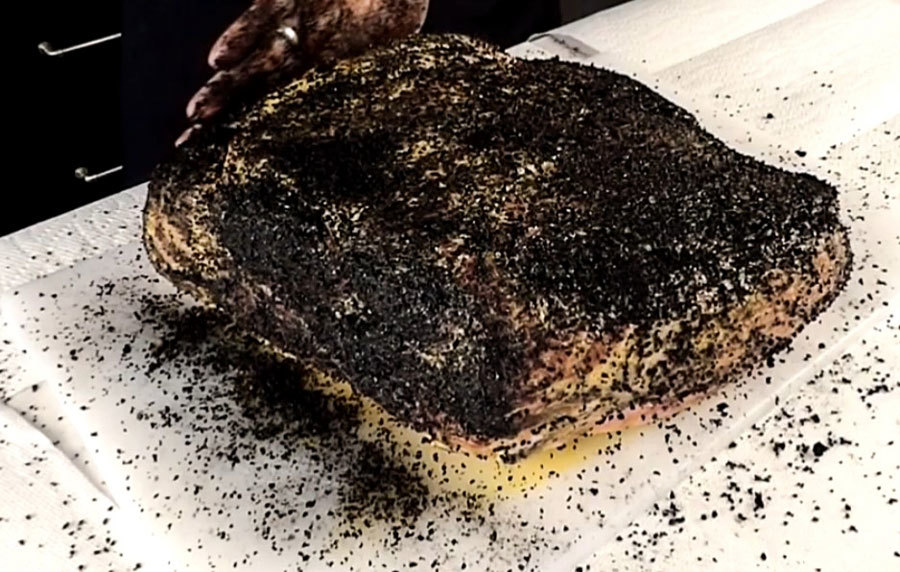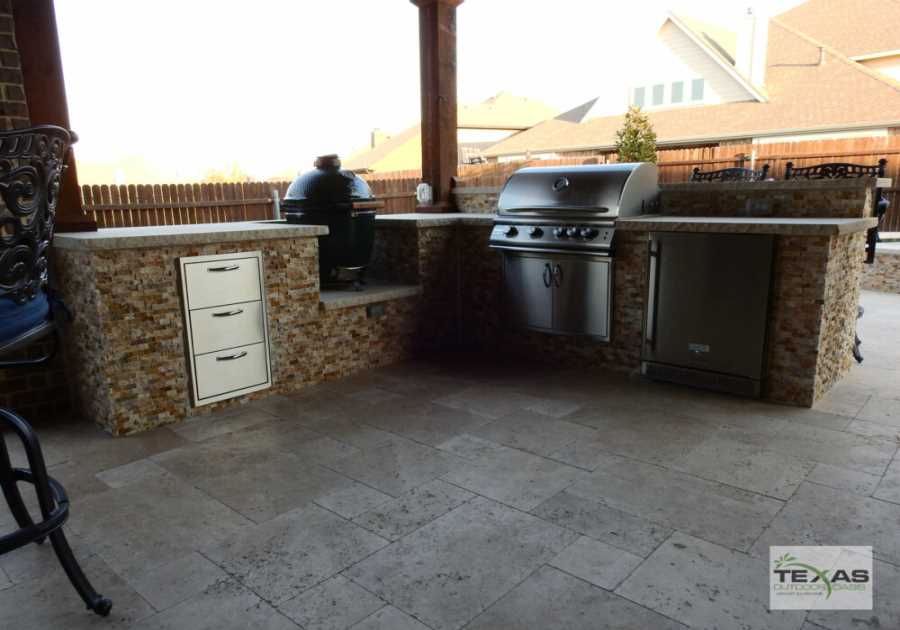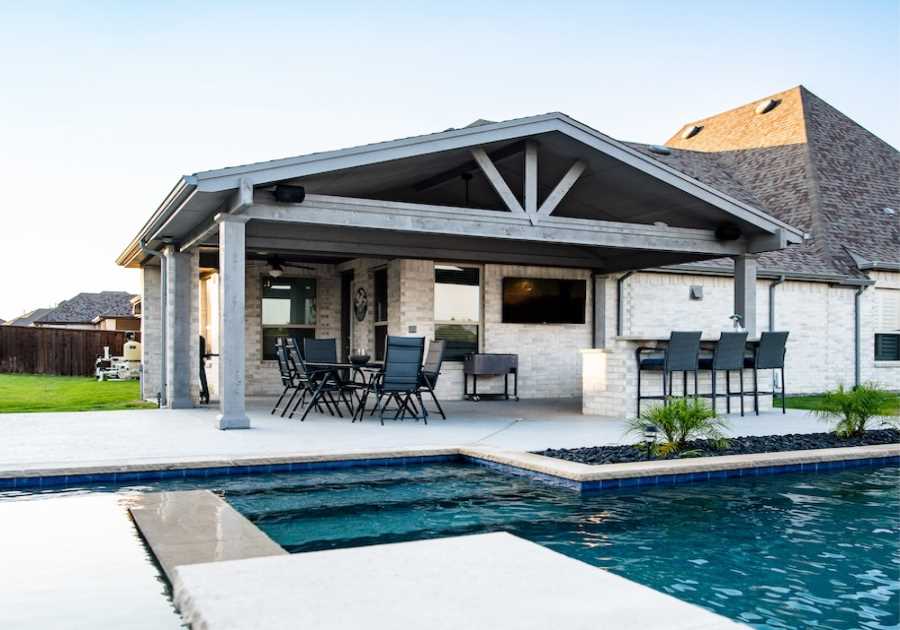Barbecue is one of the oldest cooking techniques in the world, yet we know very little about the science behind it. The idea is simple: you cook your food over a flame, which caramelizes it and creates a tasty brown crust. But what happens to the flavor afterward? Why doesn’t the meat look charred anymore? And what is the bark?
The bark of a BBQ is a flavorful, crisp, and often spicy layer of meat that gets it is a great taste from the caramelization of sugars and proteins that is smoked or grilled. It’s a result of the Maillard reaction, a chemical reaction that occurs when meat is cooked at high temperatures. The barbecue bark results from a combination of the spice rub, grill or smoker temperature, sugar, moisture, and basting sauce. The bark is not only a great flavor enhancer, but it also helps protect the meat from drying out.
What does BBQ bark taste like?
The barbecue bark is a crisp flavorful spicy layer of meat. The sugars and proteins in the food react with the high heat of the flame to produce a new layer of tasty bark.
Is BBQ bark bad for you?
The bark you refer to is the crisp, dark, and flavorful layer of meat that forms on top of the meat on the grill. The bark is a result of fat and juices dripping down and caramelizing on the grill. Some people feel that bark is harmful to the meat and should be wiped off. However, there is little evidence that shows that this is a bad thing to eat.
Why is the Bark Important?
Barbecue bark is a crusty layer of flavorful browned meat that can be found on the outside of grilled items. It is easily identified by its deep brown color and salty flavor.
The bark is usually created by the sugar, salt, and amino acids that are present in the meat. The sugars and amino acids caramelize at high temperatures, which creates a layer of rich, complex flavor. That is why bark is important. It is the part that shows the true cooking ability of a barbecue chef.
How is Bark Formed?
Barbecue bark is formed when the meat is exposed to high heat for an extended period of time. There are some factors, complex chemical reactions that affect bark formation. It’s not hard to produce. When you accurately integrate the following factors, you will get bark of BBQ:
1. Season Your Meat with a Good Rub
Spices are a must-have in every home, and there are few things more satisfying than cooking meat on a grill. Will a rub made with dried herbs and spices add a savory flavor to the meat? Or, do they merely give the meat a salty flavor?
The spice rub is a dry rub made from ground spices, salt, and paprika, used in the traditional English style of BBQ. It is also known by the names “London bbq rub” and “Texas bbq rub.” This type of BBQ was invented by the English Londoners who came to Texas in the 1800s to take advantage of the brisk climate.
It’s a good idea to choose your spice rubs based on the type of meat you’re seasoning and the type of meat you’re cooking. For example, a good rub for chicken and turkey would be a garlic or poultry spice rub while a good rub for beef would be a garlic spice rub. Some of the most common spices used in spice rubs include garlic, cumin, chili powder, black pepper, paprika, and oregano.
It is simply a dry rub that is typically put on before the meat is finished cooking so that the meat retains its flavor.
How do the spices we use on the grill affect the meat?
Have you ever wondered how the spice rub you use on the grill affects the meat you’re grilling? The simple answer is, it doesn’t. The rub is more of a seasoning agent and is designed to create a crust on the outside of the meat, as well as added flavor along with some health benefits. For example, the spice rubs salt and sears the meat, which helps lock in juices.
If you’re a person who enjoys grilling food, it’s entirely possible that you’ve heard the saying, “If you put a little bit of this, a little bit of that, a little bit of this and a little bit of that, you’ll have the best bark possible.
2. How does smoke affect the bark?
Next to the rub, smoke is the most important factor to gain good bark.
Smoke is a natural part of cooking meat. Moisture and minerals in the wood and charcoal add flavor to the meat by penetrating the pores. The Maillard Reaction happens between the sugar and amino acids in the meat, creating a range of flavor compounds.
What is bark smoke?
Bark smoke is the smoke that comes from cooking and smoking various types of meat, and it is one of the main types of smoke-themed infusions to cook with. It is usually made of wood or wood charcoal, but can also be made from other types of smoke, such as coal, wood, bean, or vegetable. It is most commonly used during grilling and smoking, but some people also use it during roasting and baking.
Unlike a lot of other meats that are marinated before grilling, ribs, especially beef ribs, are often smoked before grilling. The purpose is to seal in the flavors and tenderizes the meat.
The smoke that is coming off of your coals is incredibly important to the bark formation process that happens to meat as it cooks.
3. Water Vapor
Water vapor affects the bark, you may have noticed that your coals may not be burning as brightly as they once were. Or, perhaps your briquettes were burning faster than they used to, but now they’re not. This is because water vapor has decreased within the center of the firebox, which is not only affecting the intensity of the radiant heat, but also the amount of smoke that comes off the coals.
4. How does temperature affect the bark?
The temperature of a smoker or a grill is a very important factor that affects bark.
One of the best ways to get that great bark on your ribs is to use a smoker. While some smokers are so simple, they do not have digital controls, others can be complex enough to have additional settings to allow you to control how fast the smoker is heated up, the type of wood you are using, and the temperature of the smoker.
There’s a difference between the temperature of a smoker and the temperature of its contents. You can’t control the temperature of the ambient air, but you can control the temperature at which the food in the smoker is cooked. So, what temperature do we need to cook our meat at to have a healthy bark? The answer is different for different meats, and it depends on what you’re smoking.
In the summer, the ideal barbecue temperature is 275°F to 300°F, but you can get great barbecue at a lower temperature. The trick is to let the fire burn down to a few coals, and then add wood, which will provide a “slow burn” that will fill the smoker with smoke and keep the meat moist during the slow cooking process. The key to a great barbecue is to keep the temperature constant.
It’s an important thing, if the temperature is too low, you won’t get bark. And if the temperature is too high, the meat will burn instead of bark. To get perfect forms of bark, maintain a standard smoking temperature.
5. Moisture and basting
You may not realize it, but the way you add moisture to your barbecue is a big part of the flavor of your end product. The amount of moisture you add directly affects how much smoke flavor is infused into the food during cooking.
Perhaps the most important step in preparing barbeque food is the initial application of the basting sauce or marinade. This step is critical because if you do not do it correctly, the basting will not penetrate all the way to the meat, and you will end up with a dry bark.
This is the point, too much moisture and basting will prevent to formation of bark. Don’t need to be crazy to basting all over the meat. To start the Maillard reaction, the outside edge of the meat needs to dry out.
6. Caramelized sugar
How the sugar would impact the flavor of the bark. To my surprise, the finished product did not taste like caramel, but rather, like sugar. To make sure that I wasn’t imagining things, I repeated the test, and the results were the same each time. It turns out that the caramelized sugar not only affected the flavor of the bark, but also the color.
“Caramelization” is a term used to describe how sugar crystallizes and takes on other characteristics. That’s how sugar cane turns into brown sugar, for example. It turns out that the same thing happens when sugar is added to your favorite BBQ sauce. And, yes, caramelization can be an important process in the cooking of food, and the development of a great BBQ sauce.
Remember, don’t overcook the sugar. If the caramelized sugar becomes overcooked, it will burn outside of the meat instead of producing the bark.

How Does Fat Affect the Bark formation?
Grilled foods are popular, but they have a reputation for being unhealthy. Many people claim that fat found in meats makes them taste better, but does this really work? The short answer is yes, fat contributes to the flavor of barbecue and grilled foods, but you can still have a delicious, healthy meal without the fat.
If the heat in a smoker is so high that it actually melts fat and turns it into fuel. So, does the fat affect the bark? It does. The fat actually causes the meat to cook at a higher temperature and that causes the bark to form. For this reason, it’s important to use a high heat source when smoking food.
So, a lot of fat is not necessary for healthy bark formation.
Besides, less fat on a piece of meat doesn’t affect to get good bark. Actually, lots of fat isn’t essential, if your piece of meat contains too much fat, cut a greater portion of it off.
Which Meats are Best for Getting Good Bark?
The best meats for getting good bark are those that have a high-fat content. The fat will serve as an insulator to keep the meat from burning while cooking. These meats include ribeye, tri-tip, and strip steaks. When cooking larger pieces, like a whole brisket, you will need to make sure the meat is evenly cooked. You won’t want to have a large piece of meat where one side is well cooked and the other is still raw.
Tips for Getting Good Bark: How to Get Good Bark when Smoking Meat?
You have already known about the BBQ bark that we described above in detail. But, how do you get good bark?
Smoking meat is one of the most rewarding ways to cook since it allows you to get a ton of flavor in a relatively short amount of time. It also allows you to try different cuts of meat, learn about different cooking methods, and, best of all, cook food that most people just eat in a restaurant.
But, it is important to get good Bark when smoking meat, which is the smokiness that comes from charring the meat. There are a few tips and tricks to getting the meat to retain its moisture, color, and good bark when smoking meat.
1. Which type of wood is better to get good bark, nut wood, or fruitwood?
When people think about bark on wood smoking, it’s usually about the type of wood they use to smoke meat. For instance, people will sometimes use apple wood to smoke beef shoulder. But they’ll also use cherry wood for the same purpose.
And many people use hickory and oak for the same purpose. And others use other types of wood for smoking meat. So, which kind of wood is better when it comes to getting a good bark? The answer is neither. Both types of wood will give you a good bark, but the answer depends on where you live and what you’re smoking.
But if you want the bark to contain a little sugar, but not too much. A 5-pound beef butt should be cooked over indirect heat at 250 degrees using pecan wood (nut wood) for about 10 hours, and you’ll get a nice, crispy bark.
2. Is it important to wrap after a good bark has formed?
Yes, it is important to wrap after a good bark has formed. Since it protects the meat from losing more moisture than necessary, or from burning. This is the layer of browned, caramelized protein that forms on meat during higher-temperature cooking.

3. Why trim off thick hunks of fat to get good bark?
To get good bark, you should trim off thick hunks of fat that are above the meat. To achieve the proper bark on the meat you should take off big chunks of fat. This is because fat won’t break down as it cooks and will just sit there looking like a big hunk of fat in the middle of your delicious meat
4. Spray or baste for great bark
You can use either spray or baste to add a little flavor to the great bark of your meat. If you spray, make sure to spray the meat with some BBQ sauce. If you baste, add some BBQ sauce to the basting liquid. The sauce will caramelize and create a unique, tasty crust. Remember to be careful not to burn the bark.
5. Why you should put the meat directly on the grill grate?
Always try to put the meat directly on the grill grate to get a healthy, great bark. The reason is that the meat will come into direct contact with the grill grate, so there will be a great bark formed after you grilled your meat.
6. When is it necessary to put sugar in the rub?
Make sure the meat is dry before placing it in the smoker. Use a dry rub and seasonings to enhance the flavor of the meat.
For the sugar lover, Sugar is a sweetener that can give an extra depth of flavor to the rub. Adding sugar to the rub is especially effective with coarsely ground rubs such as a Cajun rub.
How does Your Rub Affect the Formation of the Bark?
Do you know, how does your rub affects the bark? The bark is the layer of seasoning that forms on the surface of the meat as it cooks. This seasoning is the result of the high heat of the grill breaking down the top layer of meat. The breakdown of this layer of meat creates a space between the meat and the surface of the grill. This space is filled with seasoning from the rub and the juices released by the meat.
What are the Basic Ingredients in a Rub?
There are numerous rubs on the market, and they all have a few things in common. The main ingredient is usually a grain of salt. Some rubs also include sugar or corn syrup.
Some people add their own special touch to it. The most basic ingredients are salt, pepper, and spices, such as thyme, oregano, or paprika.
Some rubs are seasonal, while others can be used year-round. Rubs can also come in many different forms, like powder, paste, paste stick, and wet rubs.
Rub Recipe for Getting Good Bark on Brisket
If you are looking for a way to get a nice crust on your brisket, you have come to the right place. An appropriate rub can take your brisket from good to great.
What is bark on a Brisket?
Before moving to the brisket recipe, let us describe what is bark on a Brisket?
Bark on a Brisket is the nice layer of seasoning that forms on brisket. Alternatively, you can say the bark on a brisket is the caramelized coating that forms while it is smoking. It is made up of juices from the meat and fat from the outside of the meat, mixed with spices.
Brisket rub recipe to get a good bark

There are different types of brisket rub in the market. But most of them are different, made with a variety of ingredients. You will see there are different styles of BBQ brisket rubs in different regions. So, you can’t say this process is wrong that we mentioned below.
Ingredients for brisket rub:
- Coarse black pepper: 2 Tablespoons
- Coarse Kosher salt: 2 Tablespoons
- Onion powder: 1 Tablespoon
- Garlic powder: 1 Tablespoon
- Smoked paprika: 1 Tablespoon
- Ground coriander: 2 teaspoons
- Mustard powder: 2 teaspoons
- Chipotle powder: 1 teaspoon
Instructions:
Step 1: At first, put together all ingredients and mix them in a bowl. Use a fork to grind any clumps of seasonings.
Step 2: You can store this brisket rub for up to a month in an airtight container.
The post What is BBQ Bark and How to Get Good Bark when Smoking Meat? appeared first on smokegears.com.
-------------------------------------
By: Theresa Lori
Title: What is BBQ Bark and How to Get Good Bark when Smoking Meat?
Sourced From: smokegears.com/bbq-bark/
Published Date: Sat, 12 Jun 2021 15:31:55 +0000






